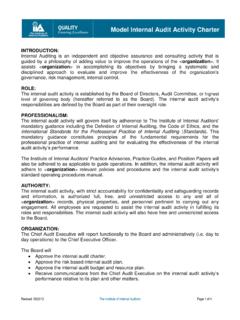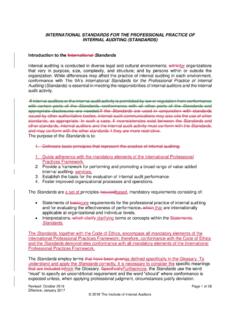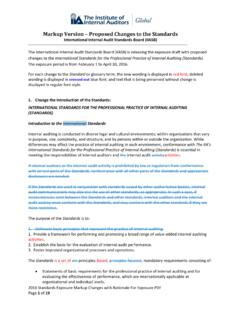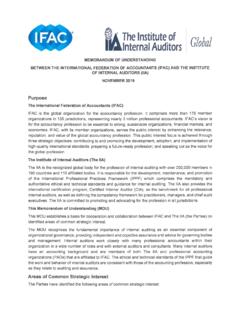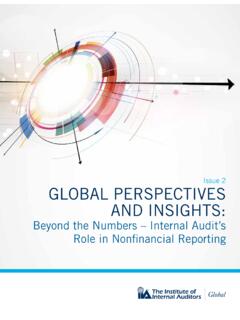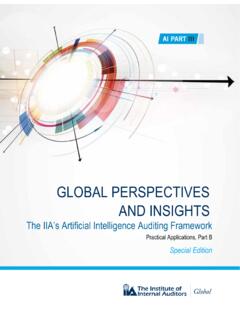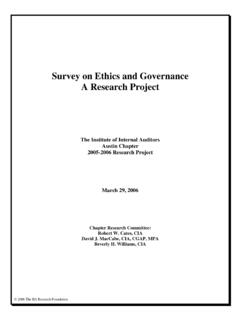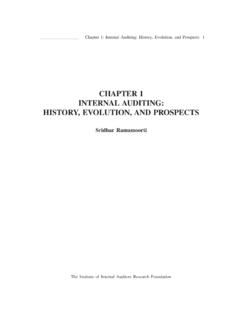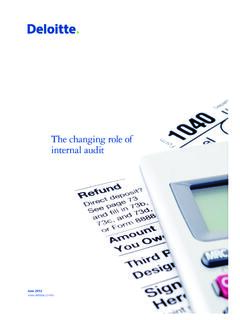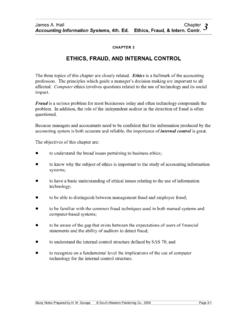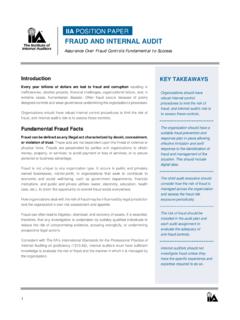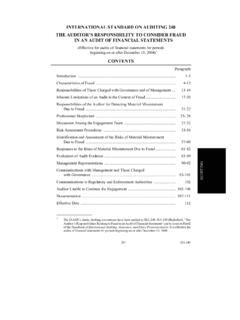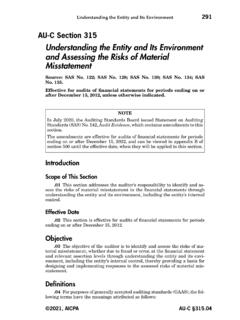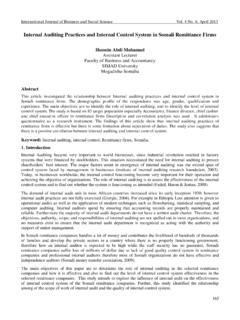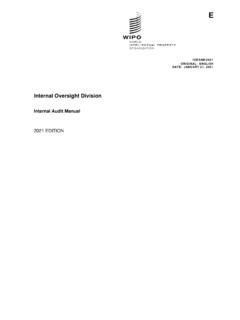Transcription of INTERNAL AUDIT COMPETENCY FRAMEWORK 1 7
1 INTERNAL AUDIT COMPETENCY FRAMEWORK 1 ! 7 Copyright 2020 by The Institute of INTERNAL Auditors, Inc. All rights AREACOMPETENCY LEVELGENERAL AWARENESSAPPLIED KNOWLEDGEEXPERTPROFESSIONALISMC ompetencies required to demonstrate the authority, credibility, and ethical conduct essential for a valuable INTERNAL AUDIT of INTERNAL auditingDescribe the purpose, authority, and responsibility of the INTERNAL AUDIT activity; distinguish between assurance and consulting ability to conduct both assurance and consulting engagements in conformance with the the INTERNAL AUDIT activity s ability to conduct both assurance and consulting activities to add value and improve the organization s AUDIT charterDescribe the purpose of an INTERNAL AUDIT charter.
2 Identify the required elements of an INTERNAL AUDIT charter, according to the an INTERNAL AUDIT charter in conformance with the Standards, and receive approval from the and revise an INTERNAL AUDIT charter to achieve conformance with the Standards and promote world- class independenceDescribe the importance of organizational independence of the INTERNAL AUDIT activity; identify the elements that a"ect any potential impairments to INTERNAL AUDIT independence and the any potential impairments to INTERNAL AUDIT independence to achieve conformance with the Standards; communicate the impact of any remaining objectivityDescribe the importance of INTERNAL AUDIT objectivity; identify factors that may impair, or appear to impair, and manage any real or perceived impairments to an individual INTERNAL auditor s objectivity.
3 Assess and maintain INTERNAL AUDIT and maintain policies that govern objectivity; recommend strategies to promote behaviorDescribe the importance of a code of ethics for INTERNAL auditors; identify the principles of The IIA s Code of individual conformance with The IIA s Code of the INTERNAL AUDIT activity s conformance with The IIA s Code of Ethics; recommend strategies to maintain and promote the highest ethical standards for INTERNAL auditors and the INTERNAL AUDIT professional careDescribe due professional due professional and conclude on the application of due professional developmentRecognize the knowledge, skills.
4 And competencies needed to fulfill the responsibilities of the INTERNAL AUDIT activity and the need for continuing professional INTERNAL AUDIT COMPETENCY through continuing professional the competencies required to fulfill the responsibilities of the INTERNAL AUDIT activity; promote professional AUDIT COMPETENCY FRAMEWORK 2 ! 7 Copyright 2020 by The Institute of INTERNAL Auditors, Inc. All rights AREACOMPETENCY LEVELGENERAL AWARENESSAPPLIED KNOWLEDGEEXPERTPERFORMANCEC ompetencies required to plan and perform INTERNAL AUDIT engagements in conformance with the governanceDescribe the concept of organizational risks related to the organization s governance policies, processes, and improvements to the organization s governance policies, processes, and types of fraud , fraud risk, and red flags for fraud .
5 Evaluate the potential for fraud and how the organization detects and manages fraud risks; recommend controls to prevent and detect fraud and educate to improve the organization s fraud forensic auditing techniques in fraud prevention, deterrence, and managementDescribe fundamental concepts of risk and risk management; describe risk management a risk management FRAMEWORK to identify potential threats; examine the e"ectiveness of risk management within processes and the methods used to assess the e"ectiveness of risk identification and controlIdentify types of an INTERNAL control FRAMEWORK to examine the e"ectiveness and e#ciency of INTERNAL and recommend improvements to the organization s INTERNAL control FRAMEWORK .
6 Assess the organization s implementation of its INTERNAL control planning Objectives and scope Risk assessment Work program ResourcesDescribe the key roles and activities involved in establishing the objectives, evaluation criteria, and scope of an the objectives, evaluation criteria, and scope of an the AUDIT engagement s objectives and scope to ensure the quality of the the purpose of performing a risk assessment during engagement planning and the steps a detailed risk assessment.
7 Including prioritizing key risks and the risk assessment process during the AUDIT the purpose of an engagement work program and key an engagement work the AUDIT engagement work the factors that influence planning for sta#ng and resource planning for an sta" and resources for an AUDIT engagement sta#ng and AUDIT COMPETENCY FRAMEWORK 3 ! 7 Copyright 2020 by The Institute of INTERNAL Auditors, Inc. All rights AREACOMPETENCY LEVELGENERAL AWARENESSAPPLIED KNOWLEDGEEXPERTPERFORMANCEC ompetencies required to plan and perform INTERNAL AUDIT engagements in conformance with the fieldwork Information gathering Sampling Computer-assisted AUDIT tools and techniques Data analytics Evidence Process mapping Analytical review DocumentationDescribe the purpose of preliminary surveys of the engagement area, checklists, and risk-and- control a preliminary survey of the engagement area.
8 Develop checklists and risk-and-control questionnaires; examine relevant information during an engagement information-gathering the various approaches to sampling, including advantages and drawbacks of appropriate sampling AUDIT engagement sampling the purpose, advantages, and disadvantages of using computer-assisted AUDIT tools and computer-assisted AUDIT tools and the use of computer-assisted AUDIT tools and techniques during the AUDIT data analytics, the data analytics process.
9 And the application of data analytics methods in INTERNAL data analytics the use of data analytics in INTERNAL potential sources of the relevance, su#ciency, and reliability of potential sources of guideline to ensure evidence is relevant, su#cient, and the purpose, advantages, and disadvantages of various process mapping appropriate analytical approaches and process mapping process mapping of the AUDIT the purpose, advantages, and disadvantages of various analytical review and apply analytical review analytical review techniques implemented during the AUDIT documentation and workpaper workpapers and AUDIT engagement AUDIT COMPETENCY FRAMEWORK 4 !
10 7 Copyright 2020 by The Institute of INTERNAL Auditors, Inc. All rights AREACOMPETENCY LEVELGENERAL AWARENESSAPPLIED KNOWLEDGEEXPERTPERFORMANCEC ompetencies required to plan and perform INTERNAL AUDIT engagements in conformance with the outcomes Communication quality Conclusions Recommendations Reporting Residual risk and risk acceptance Management action plan Results monitoringDescribe the elements of quality engagement quality engagement communications, including preliminary communication with engagement AUDIT engagement the elements of an appropriate engagement and develop engagement AUDIT engagement the importance of providing recommendations to enhance and protect organizational AUDIT engagement the engagement communication and reporting process, including interim reporting, the exit conference, obtaining management s response, the report approval process, and distribution of the an interim report.
